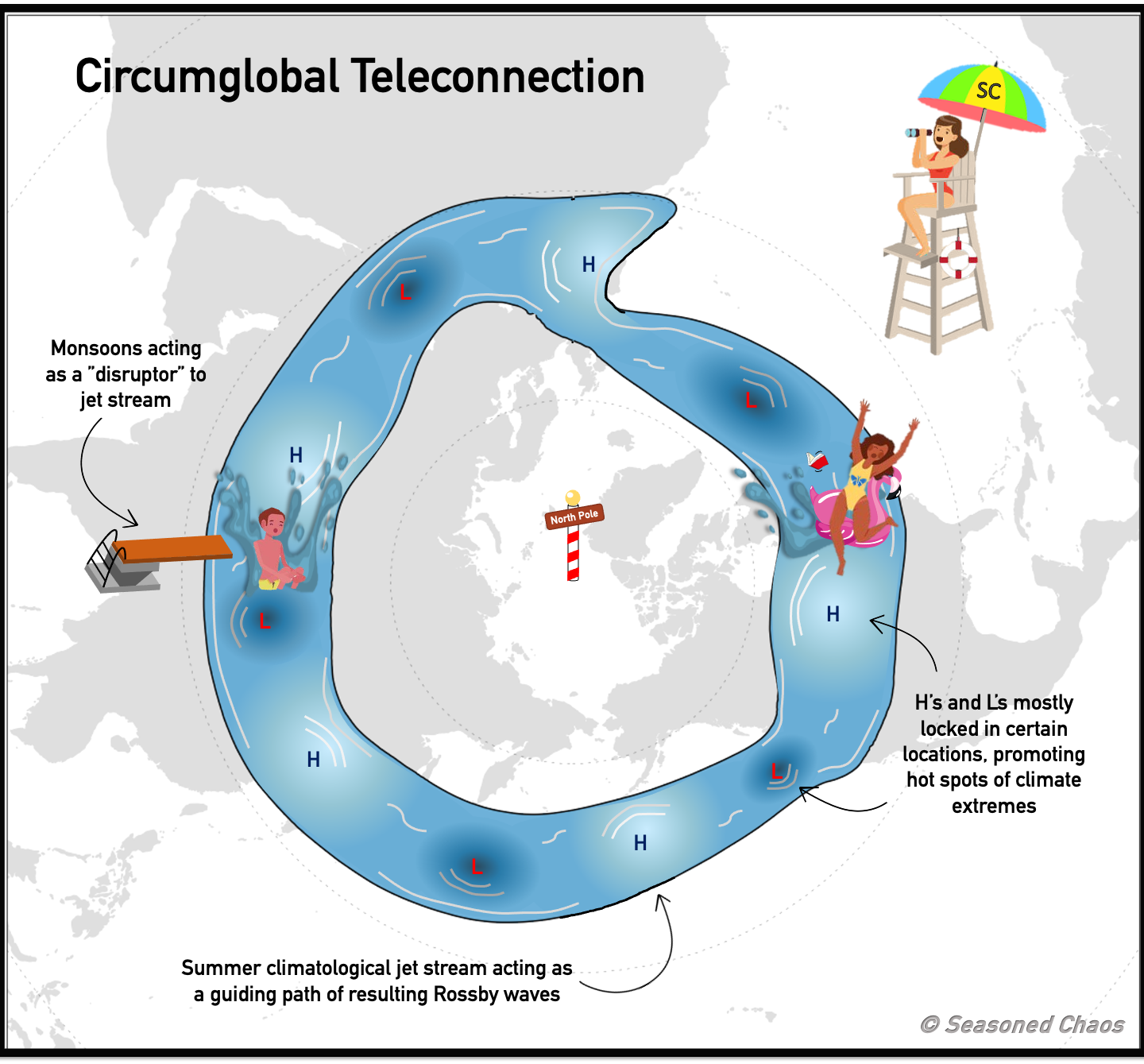Part II: Cannonball Waves vs. the Perfect Pool Day
Summer is here and* we’re heading to the pool! ![]() Seasoned Chaos, as your certified lifeguard, is prepared to give you the recap from last post:
Seasoned Chaos, as your certified lifeguard, is prepared to give you the recap from last post:
- Monsoons are seasonal shifts in wind that correspond with rainfall patterns.
- Monsoons are driven by uneven heating surfaces between the ocean and land, with rain and storminess forming over the warmer land surfaces in the summer.
- Seasonal sea surface temperature (SST) fluctuations from ENSO and the Indian Ocean can enhance or reduce the monsoonal circulation and resulting rainfall.
Alright, ready to dive in? (Pun intended) In this post, we are going to focus on how monsoon systems can generate their own Rossby wave teleconnections. As a quick refresher, Rossby waves are large-scale fluctuations (think the size of the USA!) in the jet stream that can influence global weather.
Lazy, Hazy, Crazy Days of Summer
First, let’s imagine that the jet stream in the Northern Hemisphere is a long lazy river (and this is Seasoned Chaos, so we do imagine crazy things). Summer would be a great time to grab an inflatable tube and a good book and float along the lazy river. Due to the reduced equator-pole temperature differences during this season (see our PNA post), the summer jet stream is relatively calm and shifted northward.
Remember ENSO and MJO? They can be considered the big “disruptors” of the lazy river that jump in and create giant waves. But like all of us, they take it easy during the summer. In general, this means that teleconnections (via Rossby waves) are weak since MJO and ENSO heating and storminess is less active and the jet stream is calm and farther away from the tropics.
Diving Boards and Cannonballs
But there is still something that could ruin your perfect pool day ![]() … the Asian summer monsoon is active and its enhanced rainfall is a prominent global feature during the summer. The storminess associated with the monsoon is a source of heating which can often interact with the jet stream. Because monsoon systems are slowly evolving and have semi-fixed branches, or locations, of rising air, we can represent this as fixed diving boards over the jet stream/lazy river. The monsoonal heating is like doing a cannonball jump off the diving board and into the lazy river. This perturbs the jet stream and causes rippling waves that move downstream, maybe knocking you off your tube!
… the Asian summer monsoon is active and its enhanced rainfall is a prominent global feature during the summer. The storminess associated with the monsoon is a source of heating which can often interact with the jet stream. Because monsoon systems are slowly evolving and have semi-fixed branches, or locations, of rising air, we can represent this as fixed diving boards over the jet stream/lazy river. The monsoonal heating is like doing a cannonball jump off the diving board and into the lazy river. This perturbs the jet stream and causes rippling waves that move downstream, maybe knocking you off your tube!
For example, the Indian monsoon is a branch of the Asian summer monsoon and is a major heating mechanism that maintains a circumglobal Rossby wave pattern that has “preferred” regions of high and low pressure systems in the Northern Hemisphere. This controls seasonal patterns of temperature and precipitation, as demonstrated in below figure.

A simplified view of a circumglobal teleconnection caused by Indian monsoon heating, as if we’re looking down on the whole Northern Hemisphere: The climatological jet stream, seen as the lazy river here, is relatively calm in the summer. The monsoon (or other sources of storminess) can act like a cannonball, disrupting the flow within the lazy river and causing downstream (Rossby) waves that generally follow the path dictated by the lazy river. The highs and lows of the waves can stay locked in certain locations, influencing climate extremes. Again, this is a simplified view and the surface impacts are not so contrained within confines of lazy river. Lazy river jet stream is defined here by Jun through Aug climatology of 200-mb zonal wind greater or equal to 15 m/s using ERA-5 data.
Sink or Swim...Together
Because these monsoon-forced Rossby wave patterns are considered pretty “stationary” (H’s and L’s in above figure don’t move much in space), temperature and/or precipitation extremes can be locked in certain locations. Multiple climate extremes (heatwaves, flooding) can occur simultaneously across the globe in hot spots due to monsoon-forced teleconnections guided by the flow of the jet stream lazy river (AKA, the jet stream waveguide).
The prediction skill of climate extremes on the subseasonal-to-seasonal timescale is linked to how well interactions between the monsoon system, jet stream, and Rossby waves are represented in climate forecast models. If the model’s diving board (monsoon rainfall location) is in the wrong place, or the model’s lazy river (jet stream) is too wide or too calm/slow, it can result in poor representation of the resulting Rossby waves.
Overall, with improved understanding and forecasting of monsoons and monsoon-forced teleconnections, we can better prepare for global summertime climate extremes, or, in this case, stay safely on our pool tubes.
*Okay, so maybe it’s October.
References:
- Ding, Q., and B. Wang, 2005: Circumglobal Teleconnection in the Northern Hemisphere Summer. J. Climate, 18, 3483–3505, https://doi.org/10.1175/JCLI3473.1.
- Beverley, J.D., Woolnough, S.J., Baker, L.H. et al. (2019). The northern hemisphere circumglobal teleconnection in a seasonal forecast model and its relationship to European summer forecast skill. Clim Dyn 52, 3759–3771. https://doi.org/10.1007/s00382-018-4371-4
- Malloy, K., Kirtman, B.P. The summer Asia–North America teleconnection and its modulation by ENSO in Community Atmosphere Model, version 5 (CAM5). Clim Dyn 59, 2213–2230 (2022). https://doi.org/10.1007/s00382-022-06205-4.
- Teng, H., Branstator, G. Amplification of Waveguide Teleconnections in the Boreal Summer. Curr Clim Change Rep 5, 421–432 (2019). https://doi.org/10.1007/s40641-019-00150-x